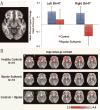Connectome signatures of neurocognitive abnormalities in euthymic bipolar I disorder
- PMID: 26228398
- PMCID: PMC4522047
- DOI: 10.1016/j.jpsychires.2015.05.017
Connectome signatures of neurocognitive abnormalities in euthymic bipolar I disorder
Abstract
Objectives: Connectomics have allowed researchers to study integrative patterns of neural connectivity in humans. Yet, it is unclear how connectomics may elucidate structure-function relationships in bipolar I disorder (BPI). Expanding on our previous structural connectome study, here we used an overlapping sample with additional psychometric and fMRI data to relate structural connectome properties to both fMRI signals and cognitive performance.
Methods: 42 subjects completed a neuropsychological (NP) battery covering domains of processing speed, verbal memory, working memory, and cognitive flexibility. 32 subjects also had fMRI data performing a Go/NoGo task.
Results: Bipolar participants had lower NP performance across all domains, but only working memory reached statistical significance. In BPI participants, processing speed was significantly associated with both white matter integrity (WMI) in the corpus callosum and interhemispheric network integration. Mediation models further revealed that the relationship between interhemispheric integration and processing speed was mediated by WMI, and processing speed mediated the relationship between WMI and working memory. Bipolar subjects had significantly decreased BA47 activation during NoGo vs. Go. Significant predictors of BA47 fMRI activations during the Go/NoGo task were its nodal path length (left hemisphere) and its nodal clustering coefficient (right hemisphere).
Conclusions: This study suggests that structural connectome changes underlie abnormalities in fMRI activation and cognitive performance in euthymic BPI subjects. Results support that BA47 structural connectome changes may be a trait marker for BPI. Future studies are needed to determine if these "connectome signatures" may also confer a biological risk and/or serve as predictors of relapse.
Keywords: Bipolar disorder; Cognition; Connectome; Go/nogo task; MRI; Response inhibition.
Copyright © 2015 Elsevier Ltd. All rights reserved.
Figures




References
-
- Altman S, Haeri S, Cohen LJ, Ten A, Barron E, Galynker II, et al. Predictors of relapse in bipolar disorder: A review. Journal of psychiatric practice. 2006;12:269–82. - PubMed
-
- Altshuler LL, Bookheimer SY, Townsend J, Proenza MA, Eisenberger N, Sabb F, et al. Blunted activation in orbitofrontal cortex during mania: a functional magnetic resonance imaging study. Biol Psychiatry. 2005;58:763–9. - PubMed
-
- Altshuler LL, Ventura J, van Gorp WG, Green MF, Theberge DC, Mintz J. Neurocognitive function in clinically stable men with bipolar I disorder or schizophrenia and normal control subjects. Biol Psychiatry. 2004;56:560–9. - PubMed
-
- Beckmann CF, Jenkinson M, Smith SM. General multilevel linear modeling for group analysis in FMRI. Neuroimage. 2003;20:1052–63. - PubMed
Publication types
MeSH terms
Substances
Grants and funding
LinkOut - more resources
Full Text Sources
Other Literature Sources
Medical
Miscellaneous

